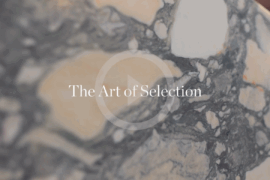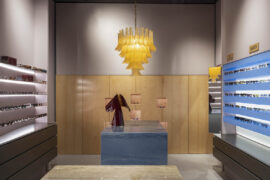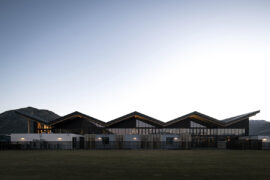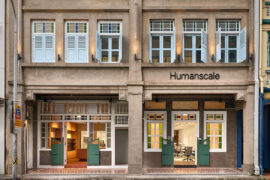Fine art that informs commercial design has authenticity and soul, and Ross Didier is at the forefront of creativity that is infused with passion.

July 8th, 2025
As if it’s not enough to be a product designer of great repute, Ross Didier returned to his roots of fine art during Melbourne Design Week this year and created a very special exhibition. Having scaled the heights of design through his company DIDIER – with a plethora of furniture collections and objects for indoors and outside – the exhibition, ANTHROPOCENE, was on show at Fletcher Arts and literally wowed the crowds.
With the detailed touch of a polished artist, Didier created a series of objects, little worlds under clear glass cloches that astounded with their intricacy, intimacy and imagination. Six petite and elaborate landscapes delighted viewers as they sat proudly on a new travertine table design from Didier, the product designer. Also displayed was a sculptural wall piece, Argonaut, a paper nautilus shell that represented an evolving embryonic form suggesting a part-animal, part-human and part-chair creature.
Ross Didier studied both Fine Art and Industrial Design at Melbourne’s RMIT and in ANTHROPOCENE his passion for fine art was just as much on display as his artistic prowess. As a labour of love, the hand-crafted pieces took many, many hours to complete to his exacting standards and the end result is perfection.

The idea of the ANTHROPOCENE collection is to showcase the infinity of creativity and how this might physically manifest through the art concept – from an original idea to the designed product. The word Anthropocene is currently a hotly debated topic in academic circles due to scientific and political controversies and refers to the current geological age, viewed as the period during which human activity has been the dominant influence on climate and the environment. To this end, Didier reminds us that as humans, we are a mere speck on the timeline when it comes to history.
Didier says: “If the entire history of the world was condensed to a single calendar year, humans appeared at about 11.37pm on December 31st.” A sobering thought indeed.
ANTHROPOCENE comprises organic forms, all handmade – mollusc interpretations, coral and mycelium-like structures; industrial materials manipulated to look like moss and shells; intriguing arrangements and exquisite detailing crafted together and arranged on earthenware plates with glass domed covers. Each represents various evolution of life forms that interact and mesh with mankind, and the delicate structures are compelling art forms.

“I just wanted to explore what’s most important to me, what I enjoy the most about design,” he reflects. “Let’s not even call it design really, it’s more creativity. What’s most important to me is the idea, and it’s a very challenging area to explore. Within a fine art environment, I do fine that there is more time to contemplate and explore those ideas, more patience to indulge with the audience.”
Somewhat akin to Victorian curiosities, these new fictional lifeforms sat atop the beautifully crafted travertine table, Stratigraphy, a limited series of three by Didier, through Fletcher Arts. It was the consummate setting for this Lilliputian installation.
As Dider explains, “I created these fictional sort of life forms under glass that represented little worlds, little landscapes, with a terrarium sort of feel. I suppose also I was presenting them within an architectural context; a language articulated to the audience. And what I liked about the installation was that these pieces were like a dinner setting around the table, presented on plates, somewhat like Michelin star desserts.”
DIDIER the design studio and workshop was established in 2000 with Dice, a chair created for Nintendo’s Head Office. Didier’s love of the natural world was evident in 2007 when he designed chairs for the restaurant Vue de Monde, incorporating kangaroo pelts, then named them ‘Functional Pets’, and in 2010 creating the Fable collection for Ketel One. Since then, the designer has conceived all manner of projects that include the Puffalo Lounging Collection, with his latest range NAUTILOID soon to be released.
Related: Exhibition on show at Bates Smart

Didier experiments by hand, prototyping and exploring his creativity launched from the workshop and then realised in various collaborations with other skilled craftspeople. It’s also through the latest manufacturing techniques, and by engaging complex 3D tooling as well as traditional forms of making. He likens the process of designing furniture as the closest commercial connection to sculpture.
From exceptional chairs and lounge chairs, sofas, stools, tables and ottomans to desks, screens, mirrors, storage and even an umbrella, there is no frontier of furniture and object design and making that Didier does not explore. Couple this with ANTHROPOCENE – and one wonders if there is anything this man cannot achieve.
However, always at the heart of Dider’s work is an artistic expression that informs his more commercial work. From ANTHROPOCENE has come the soul and an extrapolation of the interweaving of forms for the NAUTILOID collection, where design is pared back and almost skeletal but oh so refined. As an outdoor collection, NAUTILOID is an elegant addition that speaks of form, function and, importantly, of art.
Ross Didier has once again proven that he is a deep thinker and master of design and also art, that speaks of passion and finesse. Stretching the limits of creativity takes courage, knowledge and expertise – and Didier has all of these attributes in spades.
While the ANTHROPOCENE exhibition is now over, there is still an opportunity to view it by contacting Fletcher Arts.
DIDIER
didier.com.au
Photography
Mike Baker, Forough Yavi, Alan Mitchell



INDESIGN is on instagram
Follow @indesignlive
A searchable and comprehensive guide for specifying leading products and their suppliers
Keep up to date with the latest and greatest from our industry BFF's!

CDK Stone’s Natasha Stengos takes us through its Alexandria Selection Centre, where stone choice becomes a sensory experience – from curated spaces, crafted details and a colour-organised selection floor.

The undeniable thread connecting Herman Miller and Knoll’s design legacies across the decades now finds its profound physical embodiment at MillerKnoll’s new Design Yard Archives.

Merging two hotel identities in one landmark development, Hotel Indigo and Holiday Inn Little Collins capture the spirit of Melbourne through Buchan’s narrative-driven design – elevated by GROHE’s signature craftsmanship.

A calm, gallery-like boutique by Brahman Perera for One Point Seven Four brings contemporary luxury and craft to Strand Arcade.

Warren and Mahoney’s The Mill in Queenstown blends architecture, wellbeing and landscape, creating a transparent training facility.
The internet never sleeps! Here's the stuff you might have missed

Humanscale’s new showroom is about the modern workplace, with ergonomic excellence, sustainable design and architectural heritage in Singapore.

Former INDE Luminary LeAmon joins the Design Institute of Australia (DIA) following more than a decade as the inaugural Curator of Contemporary Design and Architecture at the National Gallery of Victoria (NGV).